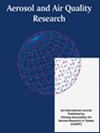考虑超低排放的防水滤料在高湿环境下的防糊袋性能
IF 2.5
4区 环境科学与生态学
Q3 ENVIRONMENTAL SCIENCES
引用次数: 0
摘要
本研究使用C8-1833拒水剂对Flumex、聚酰亚胺和膜覆盖芳纶(选择作为测试底物)进行表面处理。选择5个关键参数(C8-1833浓度、浸渍时间、滚渣率、焙烧温度、焙烧时间)考察其对滤料拒水等级和透气性变化率的影响。通过正交优化试验,确定了最佳拒水工艺参数。采用空气和粉尘过滤介质试验台,对高湿条件下防水性和膜覆盖过滤介质的防膏袋性能进行了评价。结果表明,在完全干燥过程中,滤料的防水性不受烘烤时间的影响。在防水剂浓度不低于30 g L-1、浸渍时间超过3 s、烘烤温度超过240℃、轧制残留率低于46%的条件下,两种过滤材料的防水性均达到8级。在优化的工艺条件下,滤料的防水性达到8级,接触角最大,疏水性显著增强。防水和膜覆盖的过滤介质延迟湿灰尘粘附。然而,在过高湿度的烟气中,过滤介质的持续过滤性能可能无法实现。在粘袋或快速凝结的情况下,防水过滤材料应首先使用高温烟气干燥,然后通过彻底的除尘恢复其过滤性能。本文章由计算机程序翻译,如有差异,请以英文原文为准。
Anti-paste Bag Performance of Water-repellent Filter Media in High-humidity Environments Considering Ultra-low Emissions
This study performed surface treatment of Flumex, polyimide, and membrane-covered aramid (chosen as test substrates) by the C8-1833 water-repellent agent. Five key parameters (C8-1833 concentration, impregnation time, rolling residue rate, baking temperature, and baking time) were selected to investigate their effects on the filter media’s water-repellent grade and air permeability variation rate. Through an orthogonal optimization test, the optimal water-repellent process parameters were determined. Air and dust filter media test beds were employed to assess the anti-paste bag performance of water-repellent and membrane-covered filter media under high-humidity conditions. The results indicate that the water-repellent grade of the filter media was unaffected by the baking time during complete drying. At water- repellent agent concentrations of no less than 30 g L-1, impregnation times exceeding 3 s, baking temperatures exceeding 240℃, and rolling residue rates below 46%, both filter materials achieved a water-repellent grade 8. Under optimized processing conditions, the water-repellent grade of the filter media reached 8, and the contact angle was maximized, significantly enhancing the hydrophobicity. Both water-repellent and membrane-covered filter media delayed wet dust adhesion. However, in excessively high humidity of flue gas, sustained filtration performance of the filter media might not be achievable. In bag sticking or rapid condensation situations, the water-repellent filter material should be initially dried using high-temperature flue gas and subsequently restores its filtration performance through thorough dust cleaning.
求助全文
通过发布文献求助,成功后即可免费获取论文全文。
去求助
来源期刊

Aerosol and Air Quality Research
ENVIRONMENTAL SCIENCES-
CiteScore
8.30
自引率
10.00%
发文量
163
审稿时长
3 months
期刊介绍:
The international journal of Aerosol and Air Quality Research (AAQR) covers all aspects of aerosol science and technology, atmospheric science and air quality related issues. It encompasses a multi-disciplinary field, including:
- Aerosol, air quality, atmospheric chemistry and global change;
- Air toxics (hazardous air pollutants (HAPs), persistent organic pollutants (POPs)) - Sources, control, transport and fate, human exposure;
- Nanoparticle and nanotechnology;
- Sources, combustion, thermal decomposition, emission, properties, behavior, formation, transport, deposition, measurement and analysis;
- Effects on the environments;
- Air quality and human health;
- Bioaerosols;
- Indoor air quality;
- Energy and air pollution;
- Pollution control technologies;
- Invention and improvement of sampling instruments and technologies;
- Optical/radiative properties and remote sensing;
- Carbon dioxide emission, capture, storage and utilization; novel methods for the reduction of carbon dioxide emission;
- Other topics related to aerosol and air quality.
 求助内容:
求助内容: 应助结果提醒方式:
应助结果提醒方式:


